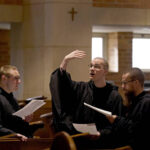
Published October 4, 2023
Hopes, Fears, and the People of God “On the Move”
Synod-2023, which opens today with a concelebrated Mass in St. Peter’s Square, is the subject of a broad range of hopes and fears. Some hope it will usher in a New Model Catholicism that fulfills the promise of the “Spirit of Vatican II”; others fear that it will accelerate the deconstruction of the Catholic Church according to the pattern set over the past several hundred years by liberal Protestantism. For over a decade now, Pope Francis has rightly warned the Catholic Church against excessive self-referentiality, calling Catholics to be missionary disciples in a Church permanently in mission. Yet the two-year process leading up to Synod-2023 seems to many to have been a Long March through the Bogs of Self-Referentiality: one in which approximately 1 percent of the world Church has spent an inordinate amount of time considering what various parties imagine to be wrong with Catholicism, and too little time examining the ways the Church is already in mission—and vibrantly so.
Then there is the matter of the process designed by the Synod General Secretariat for this month’s deliberations by bishops, priests, consecrated religious, and lay Catholics. Much of the Synod’s time will be spent in small, language-based discussion groups, the membership of which will be regularly churned; and in those groups, facilitators who are not members of the Synod per se will lead “Conversations in the Spirit” according to a strictly defined agenda of questions. It remains to be seen where this kind of process, supplemented by general congregations in which (according to the published synodal schedule) there is insufficient time for all Synod members to speak to the entire assembly, will lead.
Cardinal Mario Grech, the general secretary of the Synod, has invited the entire Church to join in prayer for Synod-2023, and was even kind enough to provide the world’s bishops with general intercessions to be used at Sunday and daily Masses over the next month. Yet while the Church is praying for and with the Synod, information about the Synod’s conversations will be largely filtered through the Holy See Press Office, which has, in previous Synods, shown a disturbing tendency to, well, filter the news.
In a September interview with the Spanish Catholic website Info Vaticana, Cardinal Gerhard Ludwig Müller, prefect-emeritus of the Dicastery for the Doctrine of the Faith and a papal appointee to the Synod’s membership, expressed in succinct form the hopes and fears surrounding Synod-2023. Asked about his hopes for the Synod, the cardinal replied, in words that will resonate with any serious Catholic, “I pray that all of this will be a blessing and not a harm to the Church.” Müller then spoke to many Catholics’ concerns by adding, “I am also committed to theological clarity so that a Church gathered around Christ doesn’t become a political dance around the golden calf of the agnostic spirit of the age.”
The cardinal urged all members of Synod-2023 to “study the first chapter of Lumen Gentium [Vatican II’s Dogmatic Constitution on the Church], which deals with the mystery of the Church in the Triune God’s plan of salvation . . .”
This was wise counsel. If Synod-2023 is to be fruitful in intensifying the evangelical dynamism of a Church permanently in mission—a Church of missionary disciples—it must be a Synod flowing from the actual teaching of the Council, and particularly the Council’s two fundamental texts: the Dogmatic Constitution on Divine Revelation (Dei Verbum) and the Dogmatic Constitution on the Church. The riches of these documents have yet to be fully plumbed by the world Church, and so it may be helpful to recall two crucial points, one from each text.
Dei Verbum asserts without apology that divine revelation is real; that its authority is binding over time; and that what God has revealed as truth, the Church has no authority to change. Lumen Gentium begins, not with “The Catholic Church is . . .” but with the affirmation that Jesus Christ, the completion and fullness of God’s self-revelation, is the “light of the nations”: the One in whom, as the Council also taught, we learn the truth about God and the truth about ourselves and our noble destiny.
Which is to say, those who participate formally or informally in Synod-2023 do not live in a claustrophobic and silent world that is the accidental product of random cosmic biochemical forces. Rather, everyone engaged in Synod-2023, formally or informally, lives in a creation that has been redeemed by Jesus Christ and is continually sanctified by Christ’s gift of the Holy Spirit. And it is Christ’s Church that meets in Rome this month, precisely to be a “light to the nations” through the proclamation of Christ’s Gospel.
Synod-2023’s Instrumentum Laboris (IL or working document) begins with the assertion that “the People of God have been on the move since Pope Francis convened the whole Church in Synod in October 2021.” That struck many as a curious formulation when the IL was first published several months ago. For surely the “People of God” (one of Lumen Gentium’s images for the entire Church) have been “on the move” since the first Christian Pentecost, some two millennia ago. And despite the challenges of what Cardinal Müller described as “the agnostic spirit of the age,” the “People of God” have been on the move long before the current synodal process was convened by Pope Francis two years ago. To take but one example: The Catholic Church in sub-Saharan Africa, Catholicism’s greatest area of growth, has been “on the move” for decades—and the lessons of that journey will be brought to Synod-2023 by some of the Church’s most impressive leaders.
The People of God have also been “on the move” in vibrant, growing Catholic campus ministries like those I recently visited at Texas A&M University and North Dakota State University.
The People of God have been “on the move” in marriage-preparation and catechetical programs that make creative, age-appropriate use of St. John Paul II’s Theology of the Body.
The People of God have been “on the move” in Courage, a ministry to those experiencing same-sex attraction that combines compassion and truth, while always keeping the focus on conversion in and to Christ
The People of God have been “on the move” in growing institutes of consecrated life that, by their countercultural manner of life, challenge the postmodern world to live life as self-gift rather than self-assertion.
The People of God have been “on the move” in founding, funding, and staffing crisis pregnancy centers in service to women and their unborn children.
The People of God have been “on the move” in those parishes that evangelize their communities, and in seminaries that form men to be missionary priests in once-intensely Catholic regions where “Christendom” has breathed its last.
The People of God have been “on the move” in innovative media ministries that seek to set the world on fire through the fire of the Word.
One hope for Synod-2023 must therefore be that the synodal assembly, and indeed the entire Catholic Church, becomes more familiar with the many ways in which the Church today is already vibrantly alive and “on the move,” because men and women have embraced Jesus Christ as Lord, to the glory of God the Father.
George Weigel
What I Would Say to the Synod
Synodal Christocentricity, the basic Christian proclamation (“kerygma”) and Vatican II are discussed in the following essay, which Father Robert P. Imbelli has kindly provided in response to the question of what he might say to Synod-2023.
Father Imbelli, a priest of the Archdiocese of New York, lived through the Second Vatican Council as a seminarian resident at Rome’s Capranica College (alma mater of Popes Benedict XV and Pius XII), and has been a prominent commentator on the Council’s teaching for decades. He is the author, among other works, of the 2014 book Rekindling the Christic Imagination: Theological Meditations for the New Evangelization (Liturgical Press), and his lifetime of theological excellence was celebrated in 2021 by over a dozen distinguished theologians in The Center Is Jesus Christ Himself: Essays on Revelation, Salvation, and Evangelization in Honor of Robert P. Imbelli (Catholic University of America Press).
Xavier Rynne II
A particularly challenging section of Pope Francis’s apostolic exhortation Evangelii Gaudium is entitled “Kerygmatic and Mystagogical Catechesis.” There Francis insists that the Church’s original kerygma “needs to be the center of all evangelizing activity and all efforts at Church renewal.” Further, he urges that this “principal” proclamation “must ring out over and over,” namely: “Jesus Christ loves you; he gave his life to save you; and now he is living at your side every day to enlighten, strengthen and free you” (EG, 164). And he adds: “All Christian formation consists of entering more deeply into the kerygma” (EG, 165).
I suggest that the Synod’s ultimate significance for the life of the Church will depend on how faithfully it appropriates that principal (in the sense of first and generative) kerygma, whose heart is Christological, and how boldly it bears witness to Christ amid a suffering and searching world. Its fruitfulness, then, will be a function of how clearly its synodality, its “journeying with,” is a journeying with Jesus Christ. In this effort, the Synod can find no surer guide than the documents of Vatican II in their magnificent Christological amplitude.
Let me briefly evoke a few Christological emphases, one from each of the Council’s constitutions, that can point the way to further faithful and creative unfolding of the Mystery of Jesus Christ.
Lumen Gentium, the Dogmatic Constitution on the Church, can only speak authentically about the Church because it first speaks about Christ. Hence the very title, the “Light of the Nations,” refers, of course, to Jesus himself. In a patristic phrase, beloved of Pope Francis, Jesus is the sun, while the Church is the moon, reflecting, in the measure that it is faithful, Christ’s light.
In that same first paragraph of the constitution, the Council goes on to teach that the Church is “in Christ like a sacrament or sign and instrument of intimate union with God and of the unity of the entire human race” (LG, 1). Undoubtedly, in our fragmented world, many thrill to the prospect of unity among peoples of all races and tongues. Hence the Council’s teaching is often cited.
Tellingly, however, it is often cited in a truncated manner—the crucial “in Christ” often being omitted. Even the Synod’s Instrumentum Laboris, which, though, in one place, quotes the Council’s sentence correctly, drops “in Christ” in other references to humankind’s unity. Thus, in the “Table of Contents” itself we read: “B 1. How can we be more fully a sign and instrument of union with God and of the unity of all humanity?”
However, unless that union and unity is confessed to be only realized in Christ (in the rich Pauline and conciliar sense of the phrase), it falls short of that “principal kerygma” upon which all efforts at Church renewal depend. The Synod cannot satisfy itself with vague and generalized exhortations to the unity of humanity but must undertake the hard task of pondering why that unity is only achievable “in Christ.”
Dei Verbum, the Dogmatic Constitution on Divine Revelation, can provide the Synod further purchase upon the significance of “in Christ.” It is rightly claimed that Dei Verbum presented a more personalist and relational approach to revelation than had the manuals of the previous century. For revelation finds its center in the person of Christ “who is both the mediator and the fullness of revelation” (DV, 2). However, less commented upon is that this Christic revelation is for the sake of salvation. For in Christ God draws near “to free us from the darkness of sin and death, and to raise us up to eternal life” (DV, 4).
Yet, the Synod assembles in a cultural context where the very notions of salvation and redemption have become problematic. Not only because the concepts need always to be further explained and illuminated, but because of the conviction on the part of many that there is nothing needing redemption. Secularity’s “immanent frame” and its fostering of a “buffered self” (to use Charles Taylor’s terms) impede the realization of a salvific event that comes “from above” and is mediated by a Savior, much less a crucified Savior.
The Synod cannot ignore this cultural challenge to the generative kerygma that undergirds and animates its faith vision. For only the at-onement realized in Christ’s atonement can constitute the basis for an “inclusivity” that embodies a truly Catholic and apostolic communion. The Synod must promote a kerygmatic and mystagogical catechesis that confesses and lives by the mysterium fidei—not a merely rote acclamation, but a life-giving realization that we are one only in Christ.
Here, Sacrosanctum Concilium, the Council’s Constitution on the Sacred Liturgy, offers indispensable resources. For the “mystery of faith” is the paschal mystery of Jesus Christ: his saving death, resurrection, and ascension. As Sacrosanctum Concilium attests: through his paschal mystery “by dying Christ the Lord destroyed our death and by rising he restored our life” (SC, 5). Hence, the “full, conscious, and active participation in liturgical celebrations” (SC, 14) advocated by the Council is primarily a participation in the paschal mystery. It is a call to experience personally the salvific action of Christ in our lives.
It is, of course, theologically and pastorally essential to stress that through baptism all are called to fullness of life in Christ and to active participation in the Church’s mission. However, it is imperative that baptism not be considered a sociological certificate of citizenship with certain civil rights, but as the sacramental seal of a radical conversion of life. As Sacrosanctum Concilium insists, “through baptism people are plunged into the paschal mystery of Christ: they die with him, are buried with him, and rise with him.” Through baptism “they receive the Spirit of adoption as sons and daughters, the Spirit in whom we cry ‘Abba, Father,’ and thus become the true worshippers whom the Father seeks” (SC, 6). From baptismal conversion flows the “universal call to holiness” for all members of the Church: a grace that is free, but not cheap. As the martyrs of all ages testify: it costs not less than everything.
One final conciliar teaching that merits fuller appropriation by the Synod comes from Gaudium et Spes, the Pastoral Constitution on the Church in the Modern World. Pastoral, indeed, but not less doctrinal in its Christological confession. Here the section which concludes the “Introduction” and serves as the background and basis for all that follows has particular importance. It enumerates some of the “more profound questions” that agitate human beings: contingency, mortality, disharmony both personal and social, quest for meaning. And it boldly confesses that “Christ, who died and was raised for all, offers to men and women through his Spirit the light and strength to respond to their highest calling.” For Christ is “the key, the center, and the goal of human history.” Moreover, it insists that, amidst the flux and changes of history “there are many realities which do not change for their ultimate foundation is found in Christ, who is the same, yesterday, today, and forever” (GS, 10).
Hence, the Synod should make it abundantly clear that authentic development can only consist in a fuller appropriation of the mystery of Jesus Christ. That the Spirit of truth it invokes always leads deeper into the truth who is Jesus Christ. Indeed, that authoritative discernment and interpretation of “the signs of the times in light of the Gospel” (GS, 4) is the charism bestowed upon those being transformed in Christ.
As Synod-2023 will host twelve “fraternal delegates” from various Christian communions, LETTERS FROM THE SYNOD-2023 thought it appropriate to enlarge the conversation by inviting ecumenical and interreligious reflections on the Synod’s substance and process. The first of these essays, on “The Unsurpassable Treasure,” comes from the Anglican tradition and was penned by Hans Boersma, who is Saint Benedict Servants of Christ Professor in Ascetical Theology at Nashotah House Theological Seminary in Wisconsin.
Xavier Rynne II
Language is the womb of reality. After all, Christ is the eternal Word of God; it is in and from this Word that creation proceeds. To change language, therefore, is never an innocent thing. Tampering with linguistic conventions was a hallmark of the Reign of Terror after the French Revolution. New rules of discourse are also at the forefront of today’s woke ideologies.
None of this is news to Christians, who know that in the beginning was the Word, that the Word was with God, and that the Word was God (cf. John 1:1). In and through Christ, God utters the world into being. Human speech is an analogical participation in the eternal Word of God. We use our words either to deepen participation in God or to separate ourselves from him.
It is noteworthy, therefore, that the concluding paragraph of the Instrumentum Laboris (IL) [for Synod-2023] asks for a renewal of language. It is a renewal that is supposed to make the Gospel “accessible and attractive” to the people of our time. This final paragraph, like much of the rest of the working document, is awash in generalities. It offers no theological reflection of note on the nature of human language, on its Christological anchor, or on its grounding within the triune God.
To be sure, the IL celebrates the “diversity” of languages and cultures (cf. Rev. 7:7–9). It notes that words (such as “authority” and “leadership”) can “have very different resonances and connotations in different linguistic and cultural areas.” The IL strives, therefore, to “avoid divisive language” and encourages silence, listening, and prayer, so that we may recognize the voice of the Spirit (cf. John 10:14, 27). This way, it is suggested, we may find “consensus” on how to walk together.
The Synod on Synodality is about process: how we walk together. Delegates will talk about how we should talk. The IL is unambiguous about what constitutes a “synodal Church.” It is primarily a “listening Church,” which involves listening to those “whose voice is most often ignored.” (Here, it appears that the IL has in mind especially “remarried divorcees, people in polygamous marriages, LGBTQ+ people, etc.”) A synodal Church is also a humble and forgiving Church, a Church of encounter and dialogue, a Church unafraid of variety and diversity, and a Church that welcomes and embraces all.
These buzzwords of diversity, listening, dialogue, and boundary-less embrace do not bode well for the Synod. To be sure, it is not that the characteristics of a synodal Church are entirely alien to the Gospel (though I would dearly like to know what it might mean that the Church welcomes and embraces all—without qualifier—and that there is “no border” that should not be crossed). Generally, the IL does not simply toss out the old vocabulary, substituting altogether new discourse. Rather, it asks for a “renewal” of language.
The problem is this—and I’m afraid I have to be frank: The emperor has no clothes. The process of synodality itself has been flawed from the outset. Based on the conviction that the Church’s primary mark is that of “listening,” the process began with a “listening phase,” in which the voices of all (including those usually ignored) could be heard and so could help decide what might constitute a truly “listening” Church.
Surely, this is not a way in which the Church receives or passes on the teaching of our Lord. Jesus insists, “All things are delivered unto me of my Father: and no man knoweth the Son, but the Father; neither knoweth any man the Father, save the Son, and he to whomsoever the Son will reveal him” (Matt. 11:27). The Father delivers (or “traditions,” if neologisms are permitted) all things to the Son, and the Son reveals the Father to the apostles and so to the Church. Saint Paul insists that he “delivers” (or “traditions”) to the Corinthians what he, in turn, has “received” from the Lord (1 Cor. 11:23).
We arrive at truth, not by ensuring that everyone is listened to but by faithfully listening to the Word that is eternally begotten of the Father. Again, it is not as though the IL simply tosses out the old language. Several times it mentions “listening to” or “meditating on” the Word. The problem is that these phrases are malleable. Beginning with the Arian heresy, sola scriptura has often been used to change and subvert the sacred deposit of faith.
This deposit is not the result of polling the Church’s various constituencies. Those entrusted with the teaching office of the Church (magisterium) have a sacred duty to teach the Word both in season and out of season (cf. 2 Tim. 4:2)—regardless, in other words, of “accessibility” or “attractiveness.” The apostle warns that a time will come when people will not endure sound doctrine: “After their own lusts shall they heap to themselves teachers, having itching ears. And they shall turn away their ears from the truth, and shall be turned unto fables” (2 Tim. 4:3–4). Since the acceptance and celebration of sexual perversion has gained traction even within the Church, the strategy of starting out with listening (rather than teaching) cannot but set us on a dead-end road.
I write as an Anglican theologian who has learnt much over the years from Catholic theology—most notably from the ressourcement theologians of the twentieth century. Henri de Lubac, probably my favorite among them, reflected deeply on what distinguishes true from false development. He was convinced that development is more than mere syllogistic argumentation—as if revelation were a series of propositions, which we simply need to rationally grasp so as to remain faithful to the truth. No doubt, up to this point the advocates of synodality will nod in agreement. But de Lubac said more than just this, for he was keenly aware that the danger of relativism is right around the corner when we abandon a logical theory of doctrinal development.
How, then, did de Lubac try to remain true to the Gospel while also recognizing that it develops? Key, for de Lubac, was God’s self-revelation in Christ:
That from which we must start without ever leaving it—what is first and last—is the redemptive Action; it is the gift that God makes us of himself in his Son. . . . It is all that which, at first undivided, forms the total Object (l’Objet global), the incredibly rich Object of revelation. We can call it, to use an equivalent expression, “the Whole of Dogma” (le Tout du Dogme). And this “Whole of Dogma” is, as its name indicates, not susceptible to any increase. It, too, like the Whole of the redemptive Action, is at once first and last. It is unsurpassable.
De Lubac insisted that God’s self-giving in Christ is “the Whole of Dogma” (le Tout du Dogme). As such, it is unalterable and unsurpassable. De Lubac understood doctrinal development as monnayer Jésus—cashing in Jesus. In other words, the only thing the Church can come up with is cash (monnayage), cash that’s always already there in the treasure itself—the person of Jesus. The Church doesn’t change doctrine; nor can the Church insert new teaching. The treasure is always already there, full and complete (le Tout du Dogme). All we do is take the cash of Jesus the treasure, guard it, protect it, and work with it.
I don’t mean to sweep under the carpet the difficult issues that arise when we ask what, concretely, monnayer Jésus looks like in our own day and age. But we dare not replace the deposit of faith—Christ the treasure, the eternal Word of the Father, traditioned to the Church—with some kind of process. When it is no longer the divine Word itself but instead the renewal of language (talk about talk, synod of synodality) that takes center stage, we cannot but note with sad confidence that the treasure itself is now up for grabs.











